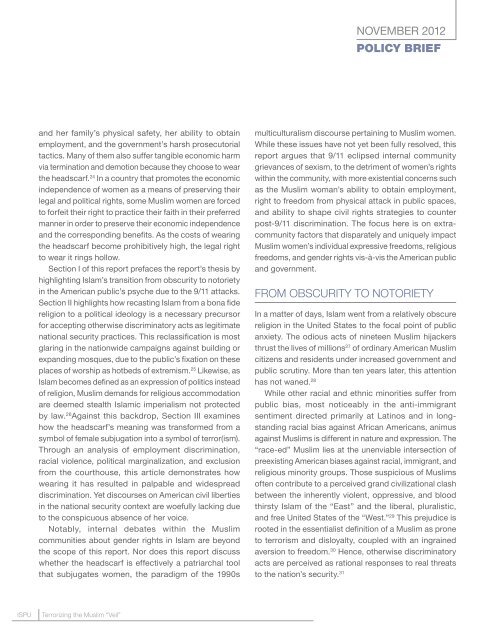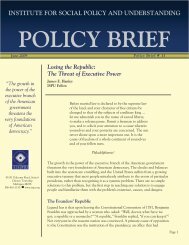ThE MuSlIM “VEIl” PoST-9/11 - Institute for Social Policy and ...
ThE MuSlIM “VEIl” PoST-9/11 - Institute for Social Policy and ...
ThE MuSlIM “VEIl” PoST-9/11 - Institute for Social Policy and ...
Create successful ePaper yourself
Turn your PDF publications into a flip-book with our unique Google optimized e-Paper software.
NOVEMBER 2012POLICY BRIEF<strong>and</strong> her family’s physical safety, her ability to obtainemployment, <strong>and</strong> the government’s harsh prosecutorialtactics. Many of them also suffer tangible economic harmvia termination <strong>and</strong> demotion because they choose to wearthe headscarf. 24 In a country that promotes the economicindependence of women as a means of preserving theirlegal <strong>and</strong> political rights, some Muslim women are <strong>for</strong>cedto <strong>for</strong>feit their right to practice their faith in their preferredmanner in order to preserve their economic independence<strong>and</strong> the corresponding benefits. As the costs of wearingthe headscarf become prohibitively high, the legal rightto wear it rings hollow.Section I of this report prefaces the report’s thesis byhighlighting Islam’s transition from obscurity to notorietyin the American public’s psyche due to the 9/<strong>11</strong> attacks.Section II highlights how recasting Islam from a bona fidereligion to a political ideology is a necessary precursor<strong>for</strong> accepting otherwise discriminatory acts as legitimatenational security practices. This reclassification is mostglaring in the nationwide campaigns against building orexp<strong>and</strong>ing mosques, due to the public’s fixation on theseplaces of worship as hotbeds of extremism. 25 Likewise, asIslam becomes defined as an expression of politics insteadof religion, Muslim dem<strong>and</strong>s <strong>for</strong> religious accommodationare deemed stealth Islamic imperialism not protectedby law. 26 Against this backdrop, Section III examineshow the headscarf’s meaning was trans<strong>for</strong>med from asymbol of female subjugation into a symbol of terror(ism).Through an analysis of employment discrimination,racial violence, political marginalization, <strong>and</strong> exclusionfrom the courthouse, this article demonstrates howwearing it has resulted in palpable <strong>and</strong> widespreaddiscrimination. Yet discourses on American civil libertiesin the national security context are woefully lacking dueto the conspicuous absence of her voice.Notably, internal debates within the Muslimcommunities about gender rights in Islam are beyondthe scope of this report. Nor does this report discusswhether the headscarf is effectively a patriarchal toolthat subjugates women, the paradigm of the 1990smulticulturalism discourse pertaining to Muslim women.While these issues have not yet been fully resolved, thisreport argues that 9/<strong>11</strong> eclipsed internal communitygrievances of sexism, to the detriment of women’s rightswithin the community, with more existential concerns suchas the Muslim woman’s ability to obtain employment,right to freedom from physical attack in public spaces,<strong>and</strong> ability to shape civil rights strategies to counterpost-9/<strong>11</strong> discrimination. The focus here is on extracommunityfactors that disparately <strong>and</strong> uniquely impactMuslim women’s individual expressive freedoms, religiousfreedoms, <strong>and</strong> gender rights vis-à-vis the American public<strong>and</strong> government.FROM OBSCURITY TO NOTORIETYIn a matter of days, Islam went from a relatively obscurereligion in the United States to the focal point of publicanxiety. The odious acts of nineteen Muslim hijackersthrust the lives of millions 27 of ordinary American Muslimcitizens <strong>and</strong> residents under increased government <strong>and</strong>public scrutiny. More than ten years later, this attentionhas not waned. 28While other racial <strong>and</strong> ethnic minorities suffer frompublic bias, most noticeably in the anti-immigrantsentiment directed primarily at Latinos <strong>and</strong> in longst<strong>and</strong>ingracial bias against African Americans, animusagainst Muslims is different in nature <strong>and</strong> expression. The“race-ed” Muslim lies at the unenviable intersection ofpreexisting American biases against racial, immigrant, <strong>and</strong>religious minority groups. Those suspicious of Muslimsoften contribute to a perceived gr<strong>and</strong> civilizational clashbetween the inherently violent, oppressive, <strong>and</strong> bloodthirsty Islam of the “East” <strong>and</strong> the liberal, pluralistic,<strong>and</strong> free United States of the “West.” 29 This prejudice isrooted in the essentialist definition of a Muslim as proneto terrorism <strong>and</strong> disloyalty, coupled with an ingrainedaversion to freedom. 30 Hence, otherwise discriminatoryacts are perceived as rational responses to real threatsto the nation’s security. 31ISPUTerrorizing the Muslim “Veil”






